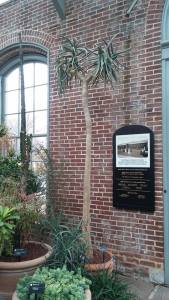Native to South Africa, this species of Aloe grows to heights of small trees (frequently to 5 meters, or 16 feet, tall). The succulent leaves grow as terminal rosettes on mature trees.
Aloe dichotoma (Quiver Tree, Kokerboom, Garas) [Aloe montana, A. ramosa, Rhipidodendrum dichotomum)
Deciduous: no
Hardiness Zones: 11-12, survives to 10 degrees Celsius (50 degrees Fahrenheit)
Height: to 7 meters (23 feet) tall, rarely to 9 meters (30 feet)
Diameter: trunk to 1 meter (3 feet), canopy to around 3 meters (10 feet) in diameter
Growth Rate: slow, to 20 centimeters (8 inches) annually
Age: may exceed 80 years old
Root System: superficial, shallow and extensive root system, previously used for Tuberculosis and Asthama (effectiveness questionable, do not consume without advisement from a certified professional)
Family: Aloeaceae/Xanthorrhoeaceae
Subspecies: none
Tolerates: drought (moderate)
Problems (major): In southern Africa, rising temperatures and increased droughts due to climate change are killing off many of these trees. Although some are performing well in cooler (typically higher altitude) regions, their ability to escape the intensifying heat can only go so far. Poorly drained soils can lead to, sometimes fatal, root rot.
Problems (minor): few
Poisonous: unknown
Soil requirements: requires light/sandy, very well-drained soils
Air requirements: survives in warm, dry regions
Watering requirement: low, somewhat drought tolerance, allow to entirely dry out between waterings
Sun requirement: full sun
Primary photosynthetic organ: leaves
Leaf structure: succulent, thick, blue-green, narrow, toothed, to 30 centimeters (12 inches) long, to 5 centimeters (2 inches) wide, arranged in rosettes on older plants but vertical rows in juveniles
Leaf shape: triangular (isosceles)
Flowering structure: bright, round yellow flowers on erect racemes of 3-5, each to 30 centimeters (12 inches) tall
Flowering frequency: June/August (“winter” in the southern hemisphere)
Monoecious/dioecious: monoecious
Monocot/dicot: monocot
Bark: smooth with gold/brown, sharp scales, coated in a white powdery substance, not real wood (instead more fibrous, soft tissues used)
Form: rounded, heavily forked
Notable characteristics:
Namibia (a southwestern African country) named the Quiver Tree its national plant due to its prominence in the country.
Uses:
When dead, some hollow out the trunks to store food or other perishable items as the bark has a natural cooling effect inside. Many birds, insects, monkeys, and other organisms use the nectar from the flowers as food. Some, in the past, have used the branches for arrows (hence the name Quiver Tree)
Sources used:
- http://www.plantzafrica.com/plantab/aloedichotoma.htm
- http://www.arkive.org/quiver-tree/aloe-dichotoma/
- http://www.kew.org/science-conservation/plants-fungi/aloe-dichotoma-quiver-tree
- http://h2g2.com/edited_entry/A26151482
- http://cmsdata.iucn.org/downloads/fact_sheet_red_list_quivertree_v2.pdf
- http://www.andersonafrica.co.za/kokerboom.html
- http://www.succulents.co.za/aloes/tree-aloes/aloe-dichotoma.php (might only be available in cached version)
- http://www.clovegarden.com/ingred/lily.html
All of the images provided were taken by me. They may be used for educational/informational purposes only, provided that this article/online journal is appropriately cited first.




What about the seed dispersal?